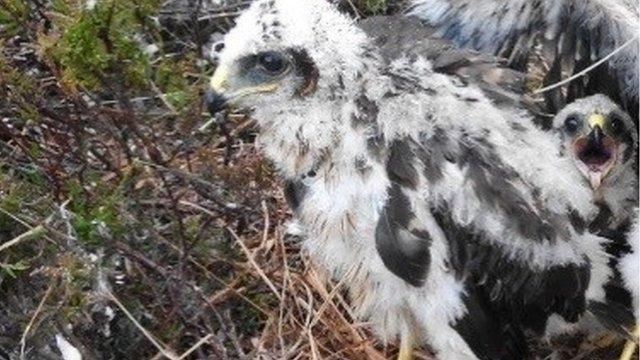Hen harrier disappearances in Angus Glens and Moffat 'suspicious'
- Published

Finn was tagged in Northumberland but disappeared near Moffat in March.
The disappearance of two hen harriers has been described as "suspicious" by RSPB Scotland.
They are seeking information - with Police Scotland - after signals from the birds' satellite tags were lost near Moffat and in the Angus Glens.
RSPB Scotland said that if the birds had died of natural causes they would have expected to find their bodies.
However, it said this had not been the case with either hen harrier and has appealed for information.
The birds - named Saorsa and Finn - were fitted with tags as part of the EU-funded Hen Harrier LIFE project.
It allows experts to track them and learn more about the threats they face.
Saorsa was tagged on a nest in Ross-shire in June 2017 but transmissions ceased in the Angus Glens on 16 February this year.

Transmissions ceased from Saorsa's tag in the Angus Glens
Finn was tagged in Northumberland in July 2016 but all trace was lost near Moffat on 25 March.
Duncan Orr-Ewing, of RSPB Scotland, said: "Satellite tags are more than 90% reliable and we would expect, if the birds had died from natural causes, to be able to recover both the tag and the body. But this has not been the case.
"The sudden disappearance of these protected rare birds shows that current legislation is not sufficient."
He called for the introduction and enforcement of licensing of "driven" grouse shooting to help protect the hen harrier.
"We are pleased that these matters are being considered by the current independent review of grouse moor management in Scotland, and look forward to some firm recommendations to Scottish government from this panel in due course," he said.
'Wide commitment'
Tim Baynes, director of the Scottish Moorland Group, said the disappearance of any protected bird was cause for concern and supported the appeal for information.
However, he said it was "perplexing" that their disappearance had been linked to "driven" grouse moors when there were none near Moffat and the grouse moor community in Angus had made a "wide commitment" to harrier conservation.
He said the incident highlighted the need for "independence" in how satellite tag data was processed.
A spokesman for the Scottish Gamekeepers Association said he hoped the two birds would be found.
"The loss of tag transmission in Angus, like the tag in Moffat, merits further, independent, investigation," he said.
He said there had been a commitment in Angus to change "past reputations" and the high number of raptors on local moors was a "sign of progress".
- Published9 August 2017
